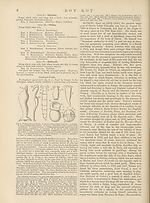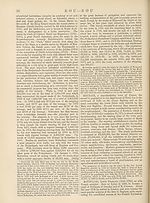Encyclopaedia Britannica > Volume 21, ROT-Siam
(19) Page 9
Download files
Complete book:
Individual page:
Thumbnail gallery: Grid view | List view

R 0 T — R O T
though unequal, is in jjarts very fine. liotrou's death
and its circumstances are known to many who never read
a line of his plays. He was in Paris when the plague
broke out at Dreux; the mayor fled, and all was con¬
fusion. Rotrou, reversing the conduct of Montaigne in
somewhat similar circumstances, at once went to his post,
caught the disease, and died in a few hours.
Rotrou s great fertility (he has left thirty-five collected
plays besides others lost, strayed, or uncollected), and
perhaps the uncertainty of dramatic plan shown by his
hesitation almost to the last between the classical and
the romantic style, have injured his work. He has no
thoroughly good play, hardly one thoroughly good act.
Rut his situations are often pathetic and noble, and as a
tragic poet properly so called he is at his best almost the
equal, of Corneille and perhaps the superior of Racine.
His single lines and single phrases have a brilliancy and
force not to be found in French drama between Corneille
and Hugo.
A complete edition of Rotrou was edited in five volumes by
Viol et le Due m 1820. In 1882 M. de Ronchaud published k
handsome edition of six plays—Sam* Genest, Venceslas,Don Bertrand
de Cabrere, Antigone, Hercule Mourant, and GWoes,—the latter
Rotrou s last play and a remarkable one. Venceslas and Saint
Collection Didot° ^ f°Und “ ^ Ghefs-d'oeuvre Tragiques of the
. ROTTERDAM, a city of the Netherlands in the pro¬
vince ^of South Holland, situated in 51° 55' 19" N. lat.
and 4° 29' 7" E. long., on the right bank of the Nieuwe
Maas at the point where it is joined by the Rotte, a small
9
the south bank of the river) into those of Delfshaven
Kralingen, and Hillegersberg. A huge dyke on which
stands Hoog Straat or High Street divides the triangular
portion into nearly equal parts—the inner and the outer
town; and the latter is cut up into a series of peninsulas
and islands by the admirable system of harbours to which
Rotterdam owes so much of its prosperity. The central
part of the river frontage is lined by a broad quay called the
Roompjes from the trees with which it is planted. From
the apex of the triangle the town is bisected by a great
railway viaduct (erected, about 1870, and mainly con¬
structed of iron), which is continued across the river to
hijenoord and the south bank by a bridge on a similarly
grand scale, the line being the Great Southern Railway
which connects Belgium and Holland and crosses the
Hollandsch Diep by the Moerdijk bridge. Parallel with
1. Groote Markt and Statue of Erasmus.
2. Bourse.
3. Post Office.
4. Boymans Museum.
stream rising near Moerkapelle. By rail it is 144 miles
south-east of The Hague and 44f south of Amsterdam.
As defined by its 17th-century fortifications the town was
an isosceles triangle with a base of 1| miles along the
river, but m modern times it has spread out in all direc¬
tions beyond the limits of its own commune (which was
increased in 1869 by the island of Fijenoord and part of
Environs of Rotterdam,
the railway bridge the municipality, in 1873, built a road-
bridge, and apart from their ordinary function these con¬
structions have proved a sufficient barrier to prevent the
ice-blocks of the upper part of the river from descending
so as to interfere with the seaward navigation. Tram¬
ways, introduced in 1880, are being gradually extended
to various suburbs. While some nine or ten Protestant
sects, the Roman Catholics, the Old Roman Catholics,
and the Jews, are all represented in Rotterdam, none of
the ecclesiastical buildings are of primary architectural
interest. The Groote Kerk or Laurenskerk is a Gothic
brick structure of the fifteenth century with a tower 297
feet high; it has a fine rood screen and an excellent
organ, and contains the monuments of Lambert Hendriks-
zoon, Egbert Meeuweszoon Kortenaar, Witte Corneliszoon
de Witt, Johan van Brakel, Johan van Liefde, and other
Dutch naval heroes. Among the more conspicuous secular
buildings are the Boymans Museum, the town-house
(restored in 1823-1827), the exchange (1723), the Delft
Gate (1766), the court-house, the post and telegraph office
(1875), the corn exchange, the seamen’s home (1855), the
hospital (1846), and the theatres. The Boymans Museum
is mainly a picture gallery, which became the property of
the town in 1847. When the building, originally erected
m 1662—63 as the assembly house of Schieland, was
burned down in 1864, most of the pictures perished, but
the museum was restored by. 1867, and the collection,
steadily recruited, is again rich in the works of Dutch
artists. The ground floor also contains the city archives
and the city library. The maritime museum, established
in. 1874 by the Yacht Club, is a remarkable collection of
ship models, and the Society of Experimental Philosophy
has a considerable collection of instruments, books, and
specimens. At the north-west corner of the town an area
of several acres is occupied by the zoological garden, which
dates from 1857. Besides the Erasmus Gymnasium the
XXL — 2
though unequal, is in jjarts very fine. liotrou's death
and its circumstances are known to many who never read
a line of his plays. He was in Paris when the plague
broke out at Dreux; the mayor fled, and all was con¬
fusion. Rotrou, reversing the conduct of Montaigne in
somewhat similar circumstances, at once went to his post,
caught the disease, and died in a few hours.
Rotrou s great fertility (he has left thirty-five collected
plays besides others lost, strayed, or uncollected), and
perhaps the uncertainty of dramatic plan shown by his
hesitation almost to the last between the classical and
the romantic style, have injured his work. He has no
thoroughly good play, hardly one thoroughly good act.
Rut his situations are often pathetic and noble, and as a
tragic poet properly so called he is at his best almost the
equal, of Corneille and perhaps the superior of Racine.
His single lines and single phrases have a brilliancy and
force not to be found in French drama between Corneille
and Hugo.
A complete edition of Rotrou was edited in five volumes by
Viol et le Due m 1820. In 1882 M. de Ronchaud published k
handsome edition of six plays—Sam* Genest, Venceslas,Don Bertrand
de Cabrere, Antigone, Hercule Mourant, and GWoes,—the latter
Rotrou s last play and a remarkable one. Venceslas and Saint
Collection Didot° ^ f°Und “ ^ Ghefs-d'oeuvre Tragiques of the
. ROTTERDAM, a city of the Netherlands in the pro¬
vince ^of South Holland, situated in 51° 55' 19" N. lat.
and 4° 29' 7" E. long., on the right bank of the Nieuwe
Maas at the point where it is joined by the Rotte, a small
9
the south bank of the river) into those of Delfshaven
Kralingen, and Hillegersberg. A huge dyke on which
stands Hoog Straat or High Street divides the triangular
portion into nearly equal parts—the inner and the outer
town; and the latter is cut up into a series of peninsulas
and islands by the admirable system of harbours to which
Rotterdam owes so much of its prosperity. The central
part of the river frontage is lined by a broad quay called the
Roompjes from the trees with which it is planted. From
the apex of the triangle the town is bisected by a great
railway viaduct (erected, about 1870, and mainly con¬
structed of iron), which is continued across the river to
hijenoord and the south bank by a bridge on a similarly
grand scale, the line being the Great Southern Railway
which connects Belgium and Holland and crosses the
Hollandsch Diep by the Moerdijk bridge. Parallel with
1. Groote Markt and Statue of Erasmus.
2. Bourse.
3. Post Office.
4. Boymans Museum.
stream rising near Moerkapelle. By rail it is 144 miles
south-east of The Hague and 44f south of Amsterdam.
As defined by its 17th-century fortifications the town was
an isosceles triangle with a base of 1| miles along the
river, but m modern times it has spread out in all direc¬
tions beyond the limits of its own commune (which was
increased in 1869 by the island of Fijenoord and part of
Environs of Rotterdam,
the railway bridge the municipality, in 1873, built a road-
bridge, and apart from their ordinary function these con¬
structions have proved a sufficient barrier to prevent the
ice-blocks of the upper part of the river from descending
so as to interfere with the seaward navigation. Tram¬
ways, introduced in 1880, are being gradually extended
to various suburbs. While some nine or ten Protestant
sects, the Roman Catholics, the Old Roman Catholics,
and the Jews, are all represented in Rotterdam, none of
the ecclesiastical buildings are of primary architectural
interest. The Groote Kerk or Laurenskerk is a Gothic
brick structure of the fifteenth century with a tower 297
feet high; it has a fine rood screen and an excellent
organ, and contains the monuments of Lambert Hendriks-
zoon, Egbert Meeuweszoon Kortenaar, Witte Corneliszoon
de Witt, Johan van Brakel, Johan van Liefde, and other
Dutch naval heroes. Among the more conspicuous secular
buildings are the Boymans Museum, the town-house
(restored in 1823-1827), the exchange (1723), the Delft
Gate (1766), the court-house, the post and telegraph office
(1875), the corn exchange, the seamen’s home (1855), the
hospital (1846), and the theatres. The Boymans Museum
is mainly a picture gallery, which became the property of
the town in 1847. When the building, originally erected
m 1662—63 as the assembly house of Schieland, was
burned down in 1864, most of the pictures perished, but
the museum was restored by. 1867, and the collection,
steadily recruited, is again rich in the works of Dutch
artists. The ground floor also contains the city archives
and the city library. The maritime museum, established
in. 1874 by the Yacht Club, is a remarkable collection of
ship models, and the Society of Experimental Philosophy
has a considerable collection of instruments, books, and
specimens. At the north-west corner of the town an area
of several acres is occupied by the zoological garden, which
dates from 1857. Besides the Erasmus Gymnasium the
XXL — 2
Set display mode to:
![]() Universal Viewer |
Universal Viewer | ![]() Mirador |
Large image | Transcription
Mirador |
Large image | Transcription
Images and transcriptions on this page, including medium image downloads, may be used under the Creative Commons Attribution 4.0 International Licence unless otherwise stated. ![]()
| Encyclopaedia Britannica > Encyclopaedia Britannica > Volume 21, ROT-Siam > (19) Page 9 |
|---|
| Permanent URL | https://digital.nls.uk/193627526 |
|---|
| Attribution and copyright: |
|
|---|---|
| Shelfmark | EB.17 |
|---|---|
| Description | Ten editions of 'Encyclopaedia Britannica', issued from 1768-1903, in 231 volumes. Originally issued in 100 weekly parts (3 volumes) between 1768 and 1771 by publishers: Colin Macfarquhar and Andrew Bell (Edinburgh); editor: William Smellie: engraver: Andrew Bell. Expanded editions in the 19th century featured more volumes and contributions from leading experts in their fields. Managed and published in Edinburgh up to the 9th edition (25 volumes, from 1875-1889); the 10th edition (1902-1903) re-issued the 9th edition, with 11 supplementary volumes. |
|---|---|
| Additional NLS resources: |
|

